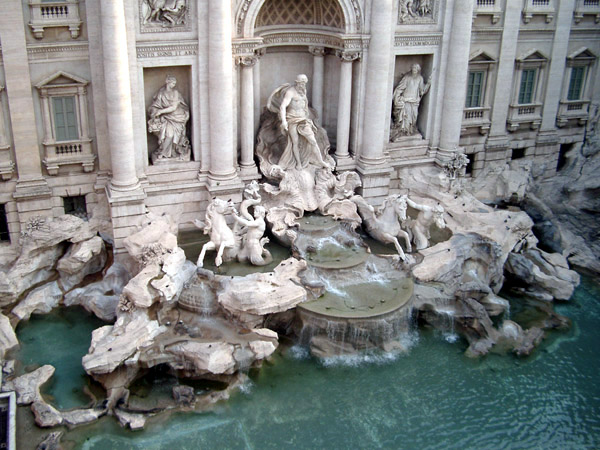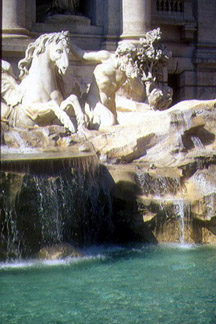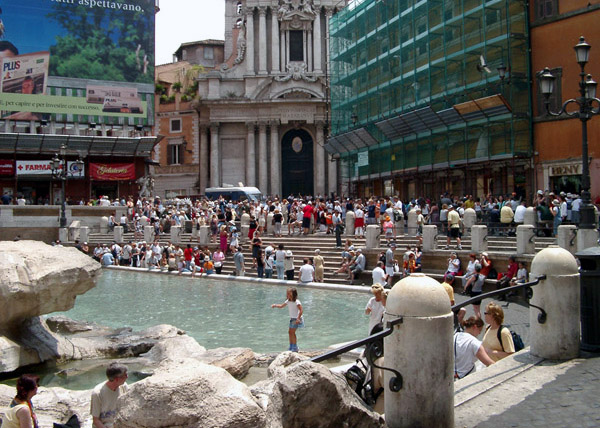|
|
 |
|
Aqueducts and the Trevi Fountain |
|
written
by floods / 09.13.2004 |
|
|
| |
Description |
| |
| |

|
| http://www.freefoto.com/ |
| Semi-Aerial View |
|
| |
|
| |

|
| http://www.freefoto.com/ |
| Horse and Triton with Conch |
|
| |
|
| |

|
| http://www.freefoto.com/ |
| The Trevi Surprise |
| Adhering to Baroque tradition, the Trevi Fountain is never fully seen while walking toward it - only the spectators' reactions and parts of the sculpture are available, until visitors are hit with the fountain's grandeur when they actually reach the fountain. |
| |
|
The Trevi fountain, which borrows elements from classical and Baroque styles, covers an entire side of the Piazza Poli in the Quirinale District, at 20 m wide and 26 m high. It is a primarily marble fountain, comprised of four Corinthian columns, an attic on a balustrade with a statue of two winged Fames, as well as extensive sculptural representations and water passages lending balance and symmetry to the entire piece.
At the top is the coat of arms of Clemente XII, which was carved by Paolo Benaglia. At the balustrade are four statues sculpted by Corsini, Ludovisi, Queirolo, and Pincellotti symbolizing the four seasons, and the benefit of water. From left to right, the statues symbolize Abundance of Fruit, Fertility of the Fields, the Gifts of Autumn, and the Amenities of Meadows and Gardens.
The center of the fountain, carved by Pietro Bracci, is a sea-shell carriage driven by two tritons commanding sea horses. The central figure is Oceanus, commander of the sea and a mythological personification of water. He holds a scepter to symbolize his authority of all water, and appears wrapped in drapery that contrast his commanding gesture. Oceanus is characterized by a full beard and head of hair, reminiscent of ancient Roman depictions of him, as well as early sculptures symbolizing youth and power. The two tritons surrounding him, one of which blows a conch, conduct the winged chariot. The horses, one calm and the other restive, imply constant motion and represent the fluctuating moods of the sea. The theatrical representations of these sculptures are characteristic of newer Baroque styles.
To the right of the niches is the “Salubrity,” or “Health,” and on the left, “Abundance,” or “Fertility,” both of which were sculpted by Filippo Valle. They appear detached and calm. Health, on the right, wears a crown and extends a cup to a sacred snake. Fertility holds a cornucopia, from which she takes a bunch of grapes. Both figures represent the benefits of the Acqua Vergine. Above these is a bas-relief by Giovan Battista Grossi and Andrea Bergondi. These sculptures illustrate the legend of Agrippa, who approved the aqueduct project to the virgin, or Roman maiden, who is showing the source to thirsty soldiers.
The basin at street level, representative of the sea, houses several rock structures constructed of tufo. The artistically carved fountain, never fully visible from the street until one is actually at it, is an exciting contrast to the city around it. The seeming randomness of the rocks contrast the strict form of the structure behind them. The sharpness of the rocks, too, contrast the sculptural flowers among them. The rocks, flowers, and rushing water add an organic element to the sculpture, helping to fuse the three components of architecture, sculpture and water which are viewed as a whole, rather than separately.
Further adding to this tension is the gridlike symmetry of the fountain’s backdrop, composed of majestic columns and rows of windows. This contrasts the seemingly arbitrary rocks below, temperamental figures, and rushing water that provides both a moving visual and an audio component. The water also plays on the sculptures, causing them to appear lifelike and moving, therefore spectators are drawn in as active participants to the scene.
The result of the diverse components is a structure which rises ambiguously from organic and jagged to smoothly crafted, or vice versa. While the entire structure is manmade, it effectively gives the impression of growing or fusing both elemental components and sculpted ones, complementing the human and godly images which also merge in the fountain. The image commands attention, dominating the square where it was built, and skewing the lines between humans and gods.
|
| |
|
| |
|
|
 |
|



